Simulation Analysis and Experimental Study on the Fluid–Solid–Thermal Coupling of Traction Motor Bearings
Abstract
:1. Introduction
2. Establishment of a Fluid–Solid–Thermal Coupling Model
2.1. Heat Generation Model
2.2. Heat Transfer Model
2.3. The Bearing Simulation Model Was Established
2.3.1. Establishment of Coupling Analysis Model
2.3.2. Establishment of Geometric Model
- (1)
- The cage rivet has little influence on the temperature field analysis of the whole bearing, so the cage structure is simplified and drawn as an ordinary cage in the pre-treatment modeling.
- (2)
- Ignore the chamfer design of the bearing in the actual test operation, reduce the number of meshes and the difficulty of drawing, and improve the accuracy of meshes.
- (3)
- The diameter of the rolling element is taken as the minimum size within the tolerance range so as to increase the gap with the inner and outer ring raceways and reduce the calculation difficulty of the overall model.
- (4)
- During the operation of the bearing, the ball is not in direct contact with the inner and outer rings, and a lubricating film will be formed in the contact area. The empirical formula of oil film thickness (8) is fully considered in flow field modeling, and mesh refinement is carried out in this area.
2.3.3. Boundary Condition Settings
3. Transient Simulation and Analysis of Grease-Lubricated Bearings
3.1. Temperature Field Analysis of Grease-Lubricated Bearings
3.2. Simulation Analysis of Grease Flow Behavior
4. Test Verification of the Temperature Field of Grease-Lubricated Bearings
5. Conclusions
- (1)
- A transient temperature field simulation method considering multi-factor heat dissipation and variable friction power consumption is proposed, which accurately predicts the change process of temperature between ball and raceway, as well as outer ring temperature during grease homogenization. The temperature in the bearing contact zone and ring initially increases to the maximum and then gradually decreases. Finally, it tends to stabilize once heat generation and dissipation reach equilibrium.
- (2)
- The fluid–solid–thermal coupling simulation analysis model can accurately predict the content of grease involved in effective lubrication in the bearing cavity, which tends to stabilize with the stability of the bearing temperature. The simulation analysis results and test results show that the grease content in the 6215 bearing cavity stabilizes at 25.57% of the initial filling amount.
- (3)
- In a comparison of simulation and experimental results, the error of the peak temperature of the outer ring is 0.93%, the error of the final stable temperature is 0.69%, and the error of the residual amount of grease in the bearing cavity is 7.52%, which prove the accuracy and effectiveness of the proposed simulation model.
Author Contributions
Funding
Data Availability Statement
Conflicts of Interest
References
- Ye, J.; Yang, L. Developing of Bearings for Rail Transit Vehicles. Bearing 2013, 12, 61–65. [Google Scholar]
- Peng, F.; Zhang, Y. General Review of Rail Transit Bearing Fault Diagnosis and Life Prediction Technology. Urban Mass Transit 2020, 23, 162–168. [Google Scholar]
- Yao, L.; Yang, H. The Trend of Greases for Railway Overseas. Pet. Prod. Appl. Res. 2006, 3, 50–53. [Google Scholar]
- Li, Q.; Chen, L.; Xu, J.; Chen, G.; Yang, G. Failure Modes of Rolling Bearings for High-speed EMUs and Prospects for Countermeasures. Bearing 2024, 3, 1–8. [Google Scholar]
- Wang, Y.; Cao, J.; Tong, Q.; An, G.; Liu, R.; Zhang, Y.; Yan, H. Study on the Thermal Performance and Temperature Distribution of Ball Bearings in the Traction Motor of a High-Speed EMU. Appl. Sci. 2020, 10, 4373. [Google Scholar] [CrossRef]
- Kavathekar, S.; Upadhyay, N.; Kankar, P.K. Fault Classification of Ball Bearing by Rotation Forest Technique. Procedia Technol. 2016, 23, 187–192. [Google Scholar] [CrossRef]
- Yu, G. Fault feature extraction using independent component analysis with reference and its application on fault diagnosis of rotating machinery. Neural Comput. Appl. 2015, 26, 187–198. [Google Scholar] [CrossRef]
- Huang, W.; Sun, H.; Luo, J.; Wang, W. Periodic feature oriented adapted dictionary free OMP for rolling element bearing incipient fault diagnosis. Mech. Syst. Signal Process. 2019, 126, 137–160. [Google Scholar] [CrossRef]
- Lugt, P.M.; Velickov, S.; Tripp, J.H. On the Chaotic Behavior of Grease Lubrication in Rolling Bearings. Tribol. Trans. 2009, 52, 581–590. [Google Scholar] [CrossRef]
- Xu, J.; Zhang, J.; Huang, Z.; Wang, L. Calculation and finite element analysis of the temperature field for high-speed rail bearing based on vibrational characteristics. J. Vibroeng. 2015, 17, 720–732. [Google Scholar]
- Chai, D.; Ding, Q.; Wang, B. Temperature field simulation of herringbone grooved bearing based on FLUENT software. In Proceedings of the 2016 IEEE Advanced Information Management, Communicates, Electronic and Automation Control Conference (IMCEC), Xi’an, China, 3–5 October 2016. [Google Scholar]
- Ma, F.; Li, Z.; Qiu, S.; Wu, B.; An, Q. Transient thermal analysis of grease-lubricated spherical roller bearings. Tribol. Int. 2016, 93, 115–123. [Google Scholar] [CrossRef]
- Xiu, S.; Xiu, P.; Gao, S. Simulation of Temperature Field of Oil Film in SuperHigh Speed Hybrid Journal Bearing Based on FLUENT. Adv. Mater. Res. 2009, 69–70, 296–300. [Google Scholar] [CrossRef]
- Wang, B.M.; Sun, C.; Xiao, C.; Liu, H. Numerical Analysis of Flow Characteristics of Grease in High-speed Angular Contact Ball Bearing. Lubr. Eng. 2018, 43, 109–115+131. [Google Scholar]
- Zhang, S.; Lin, X.; Fan, C.; Su, G.; Lu, Y. Study on Structural Optimization and Temperature Characteristics of Hydrostatic Bearing Based on Fluent. Hydraul. Pneum. Seals 2019, 39, 21–24. [Google Scholar]
- Palmgren, A. Ball and Roller Bearing Engineering; SKF Industries: Philadelphia, PA, USA, 1945. [Google Scholar]
- Deng, K.; Xie, P.; Liao, H.; Zhou, G.; Deng, S. Mechanism of Abnormal Fluctuation of Friction Torque of Control Moment Gyro Bearing Assembly. J. Aerosp. Power 2023, 38, 752–768. [Google Scholar]
- Deng, S.; Li, X.; Wang, J.; Wang, Y.; Teng, H. Analysis on Friction Torque Fluctuation of Angular Contact Ball Bearings. J. Mech. Eng. 2011, 47, 104–112. [Google Scholar] [CrossRef]
- Deng, S.; Hua, X.; Zhang, W. Analysis on Friction Torque Fluctuation of Angular Contact Ball Bearing in Gyro Motor. J. Aerosp. Power 2018, 33, 1713–1724. [Google Scholar]
- Harris, T.A.; Kotzalas, M.N. Advanced Concepts of Bearing Technology; CRC Press: Boca Raton, FL, USA, 2007. [Google Scholar]
- Ai, S.; Wang, W.; Wang, Y.; Zhao, Z. Temperature rise of double-row tapered roller bearings analyzed with the thermal network method. Tribol. Int. 2015, 87, 11–22. [Google Scholar] [CrossRef]
- Takabi, J.; Khonsari, M.M. Experimental testing and thermal analysis of ball bearings. Tribol. Int. 2013, 60, 93–103. [Google Scholar] [CrossRef]
- Takabi, J.; Khonsari, M.M. On the thermally-induced failure of rolling element bearings. Tribol. Int. 2016, 94, 661–674. [Google Scholar] [CrossRef]
- Zheng, D.; Chen, W.; Li, M. An optimized thermal network model to estimate thermal performances on a pair of angular contact ball bearings under oil-air lubrication. Appl. Therm. Eng. 2018, 131, 328–339. [Google Scholar]
- Neurouth, A.; Changenet, C.; Ville, F.; Arnaudon, A. Thermal modeling of a grease lubricated thrust ball bearing. Proc. Inst. Mech. Eng. Part J J. Eng. Tribol. 2014, 228, 1266–1275. [Google Scholar] [CrossRef]
- Zheng, D.; Chen, W. Thermal performances on angular contact ball bearing of high-speed spindle considering structural constraints under oil-air lubrication. Tribol. Int. 2017, 109, 593–601. [Google Scholar] [CrossRef]
- Pouly, F.; Changenet, C.; Ville, F.; Velex, P.; Damiens, B. Investigations on the power losses and thermal behaviour of rolling element bearings. Proc. Inst. Mech. Eng. Part J J. Eng. Tribol. 2009, 224, 925–933. [Google Scholar] [CrossRef]
- Sadeghi, F.; Sui, P.C. Thermal Elastohydrodynamic Lubrication of Rolling/Sliding Contacts. J. Tribol. 1990, 112, 189–195. [Google Scholar] [CrossRef]
- Peterson, W.; Russell, T.; Sadeghi, F.; Berhan, M.T.; Stacke, L.E.; Ståhl, J. A CFD investigation of lubricant flow in deep groove ball bearings. Tribol. Int. 2020, 154, 106735. [Google Scholar] [CrossRef]
- Lei, J.; Su, B.; Zhang, S.; Yang, H.; Cui, Y. Dynamics-Based Thermal Analysis of High-Speed Angular Contact Ball Bearings with Under-Race Lubrication. Machines 2023, 11, 691. [Google Scholar] [CrossRef]
- Crecelius, W.J.; Pirvics, J. Computer Program Operation Manual on SHABERTH. A Computer Program for the Analysis of the Steady State and Transient Thermal Performance of Shaft-Bearing Systems; US Air Force Technical Report AFAPL-TR-76-90; Defense Technical Information Center: Fort Belvoir, VA, USA, 1976. [Google Scholar]
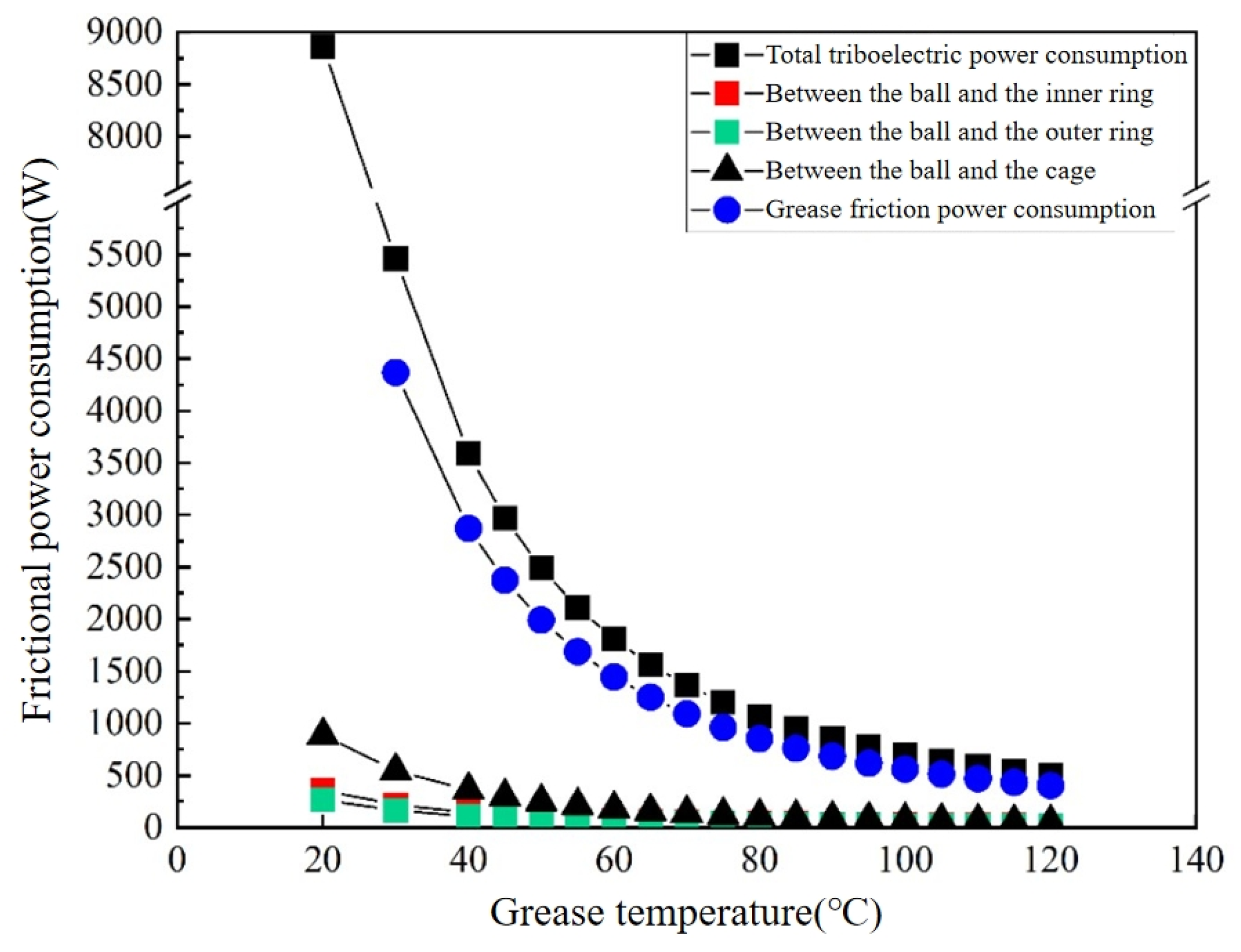
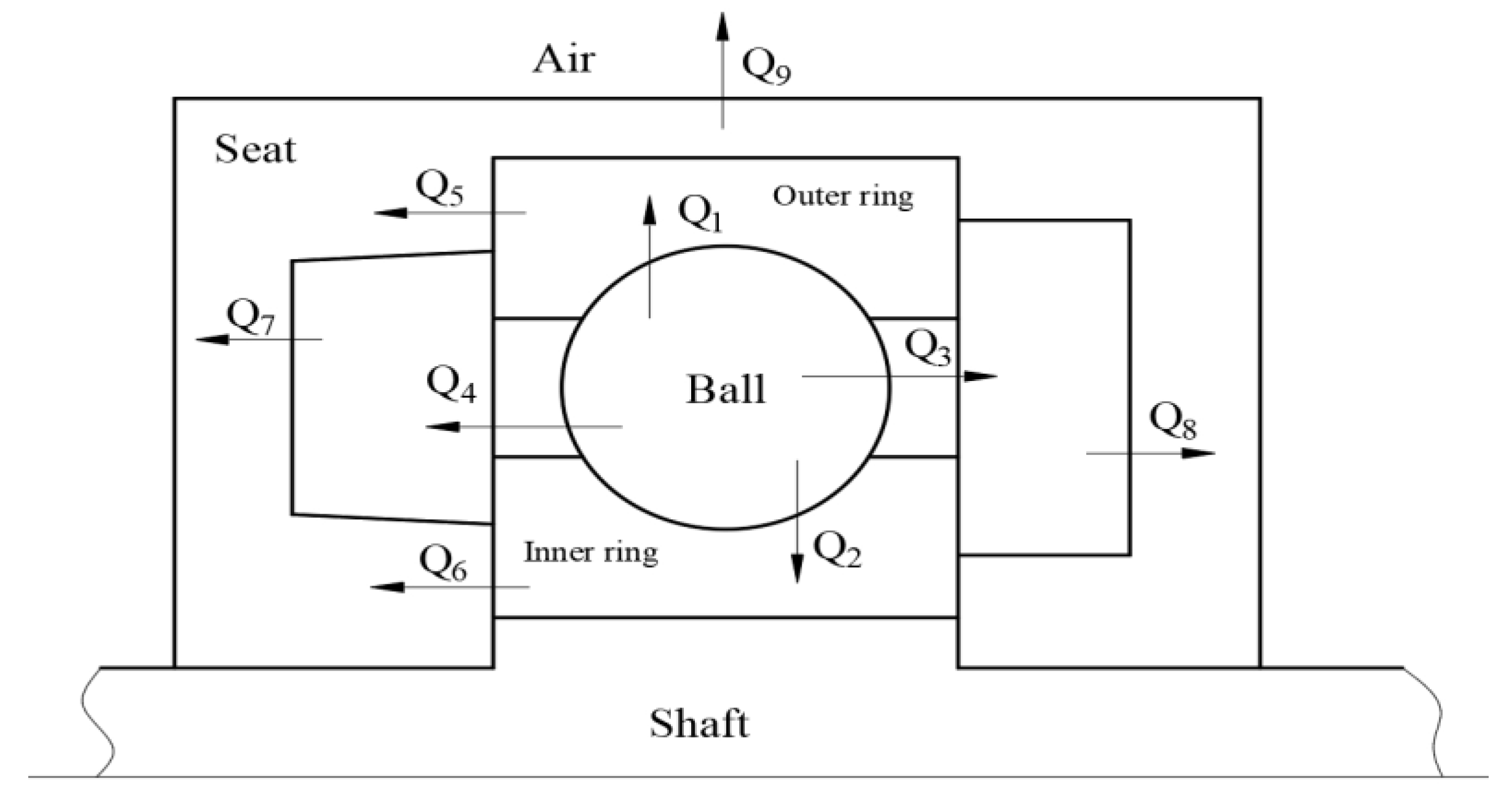

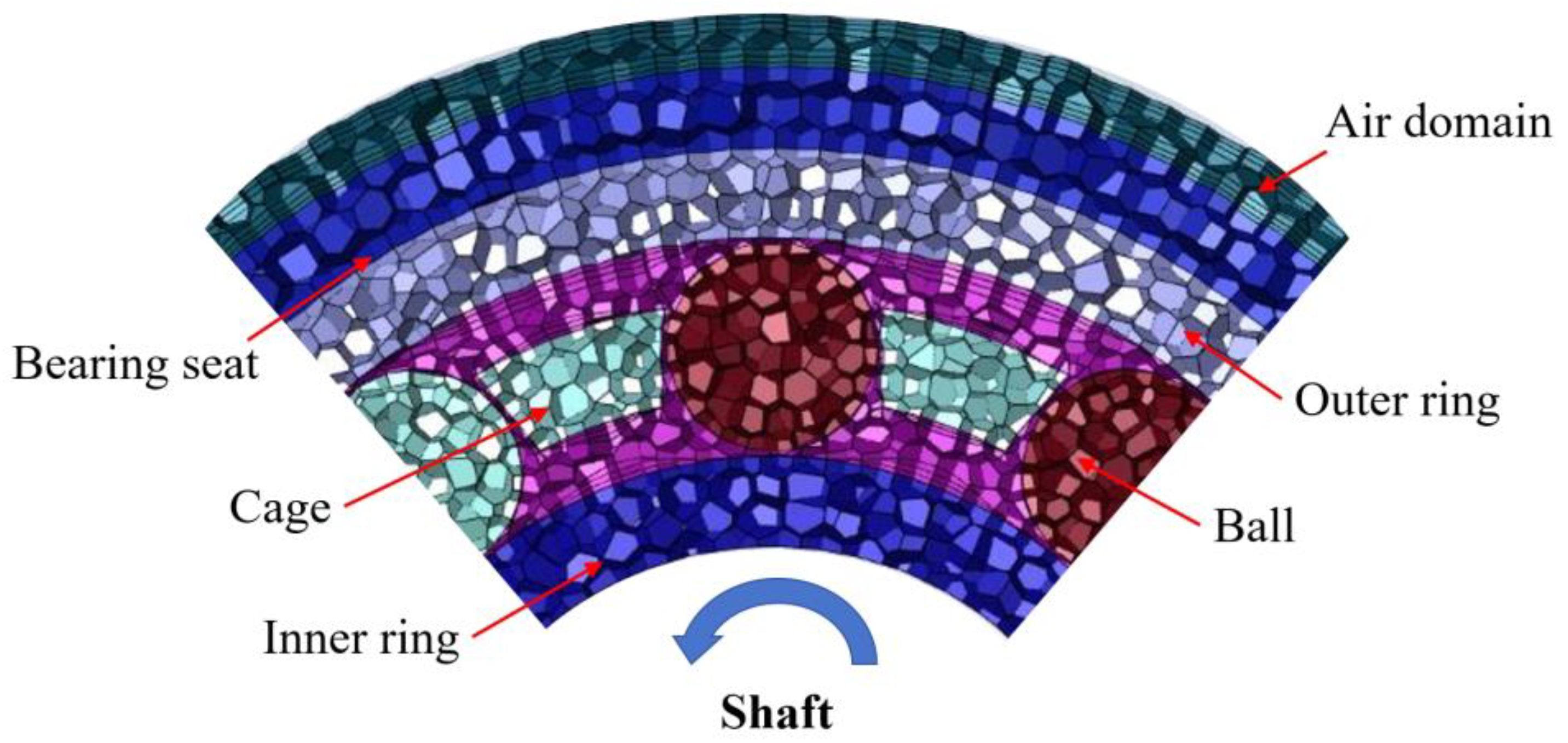
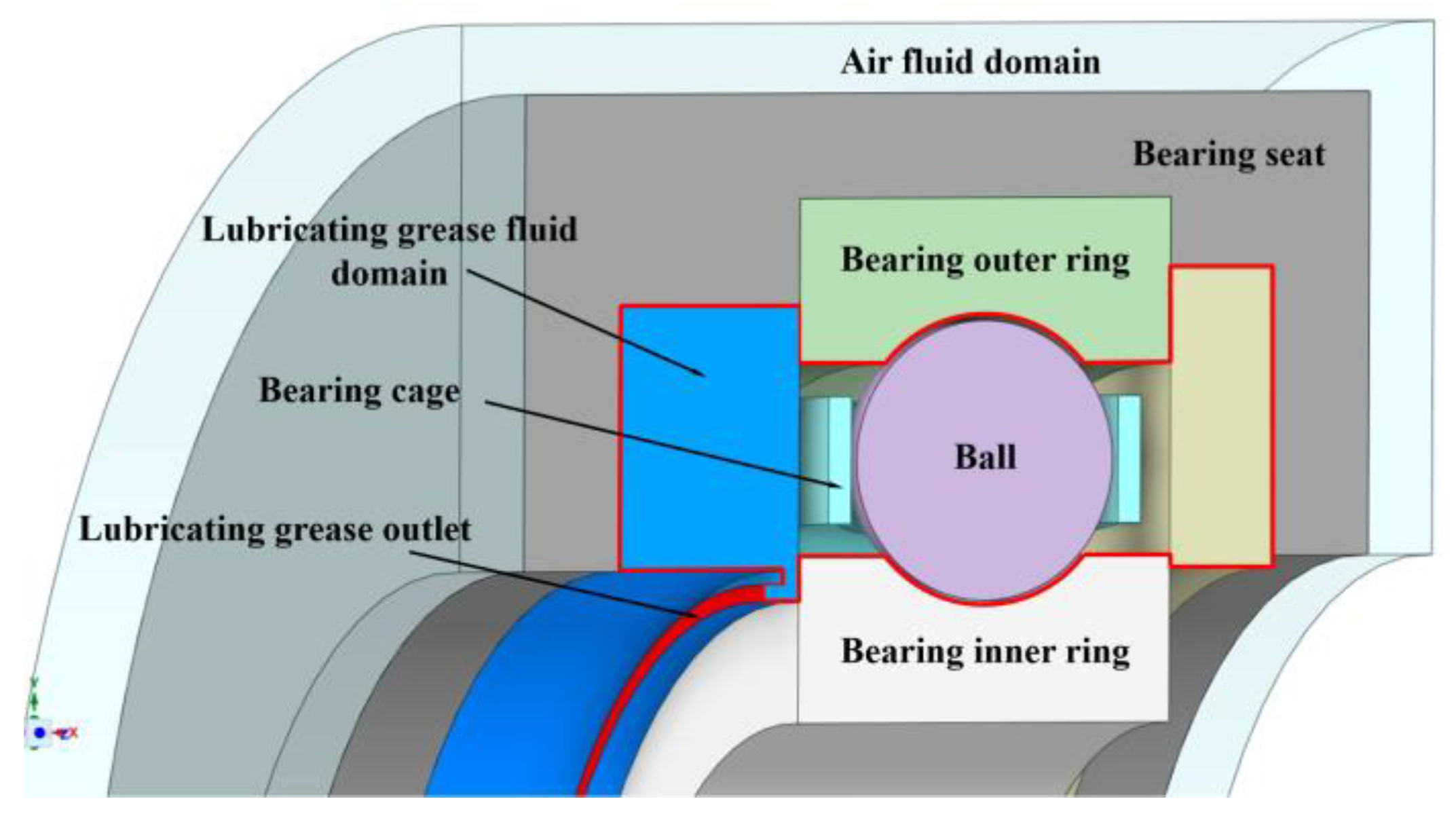




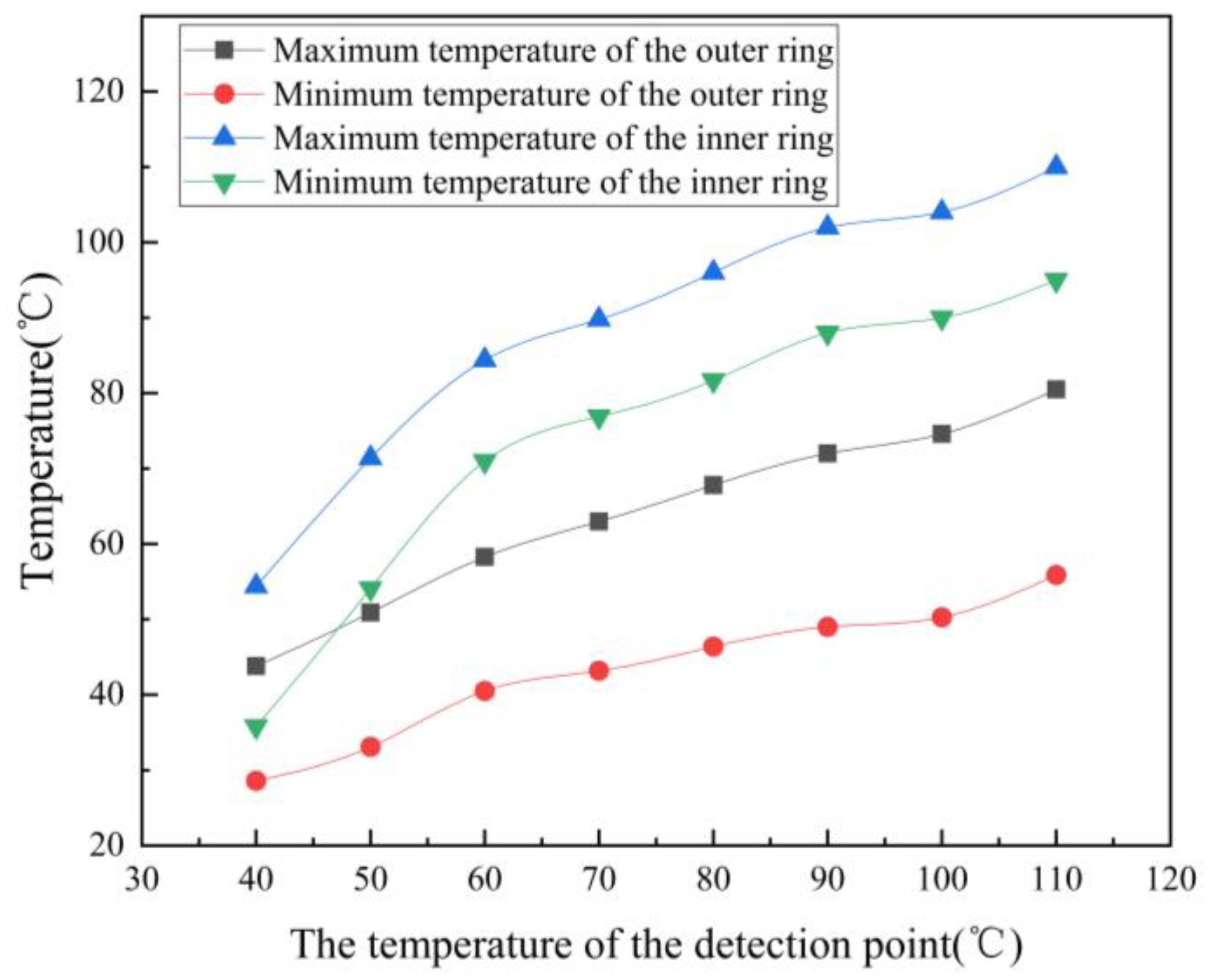

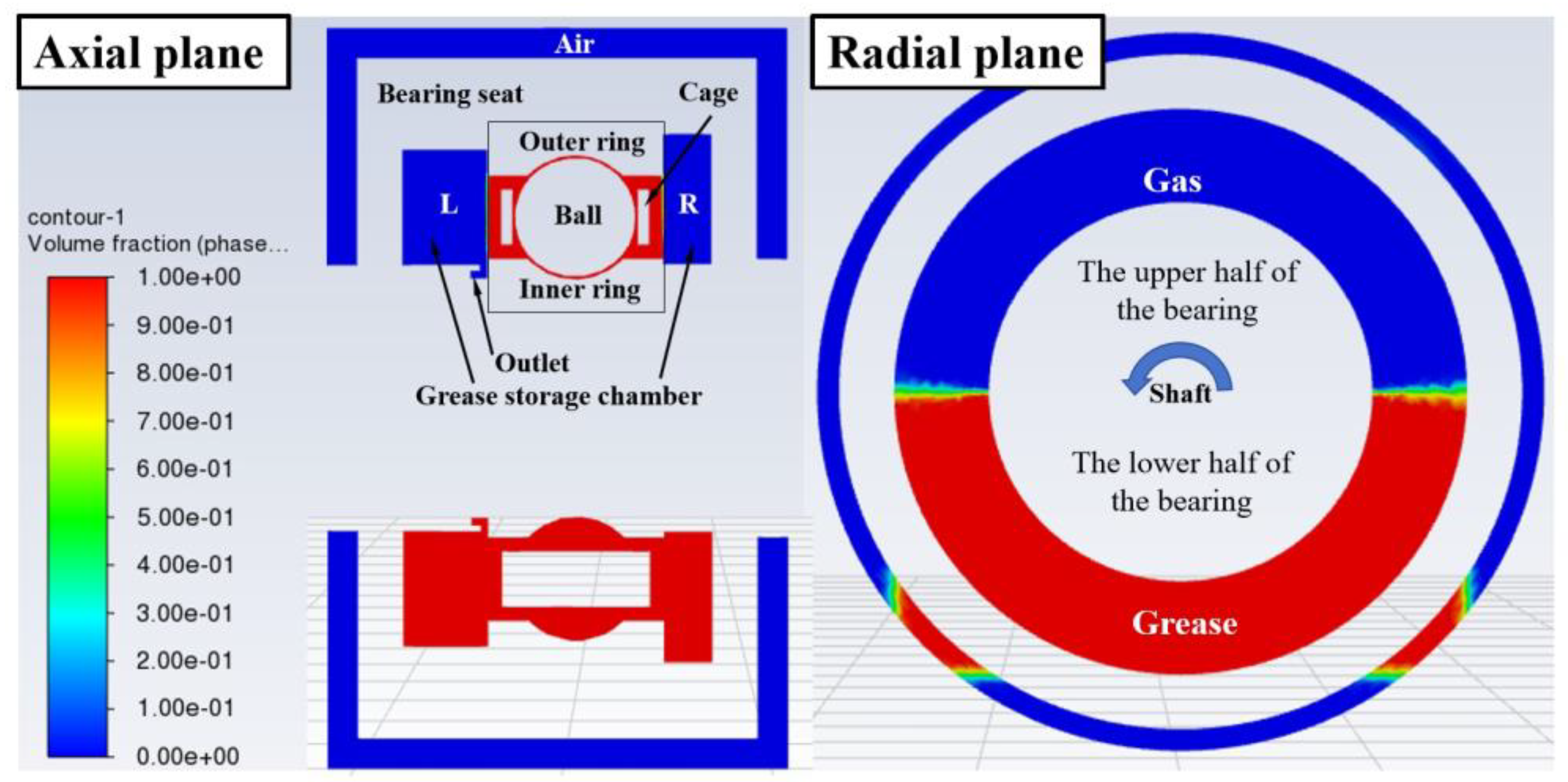
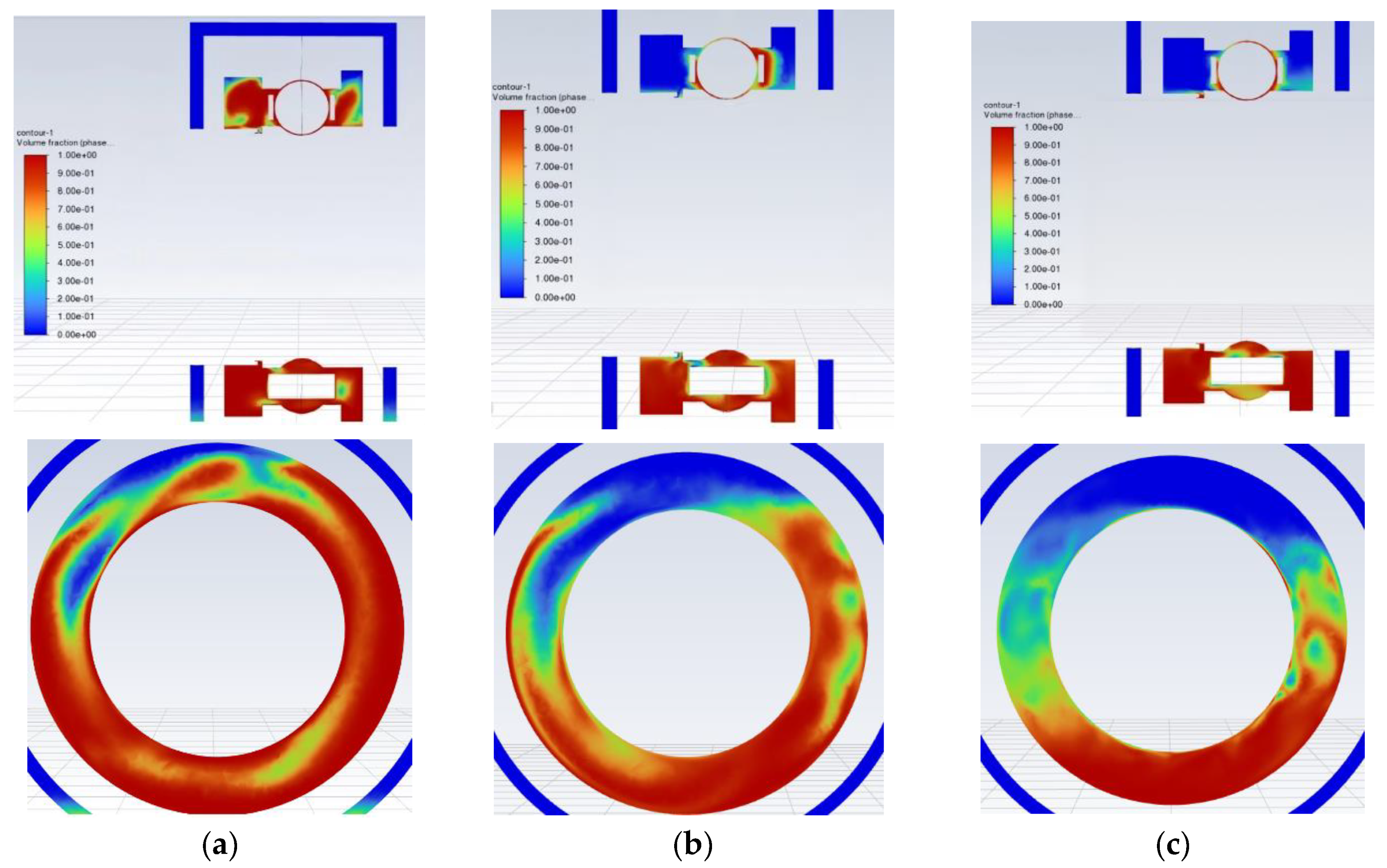


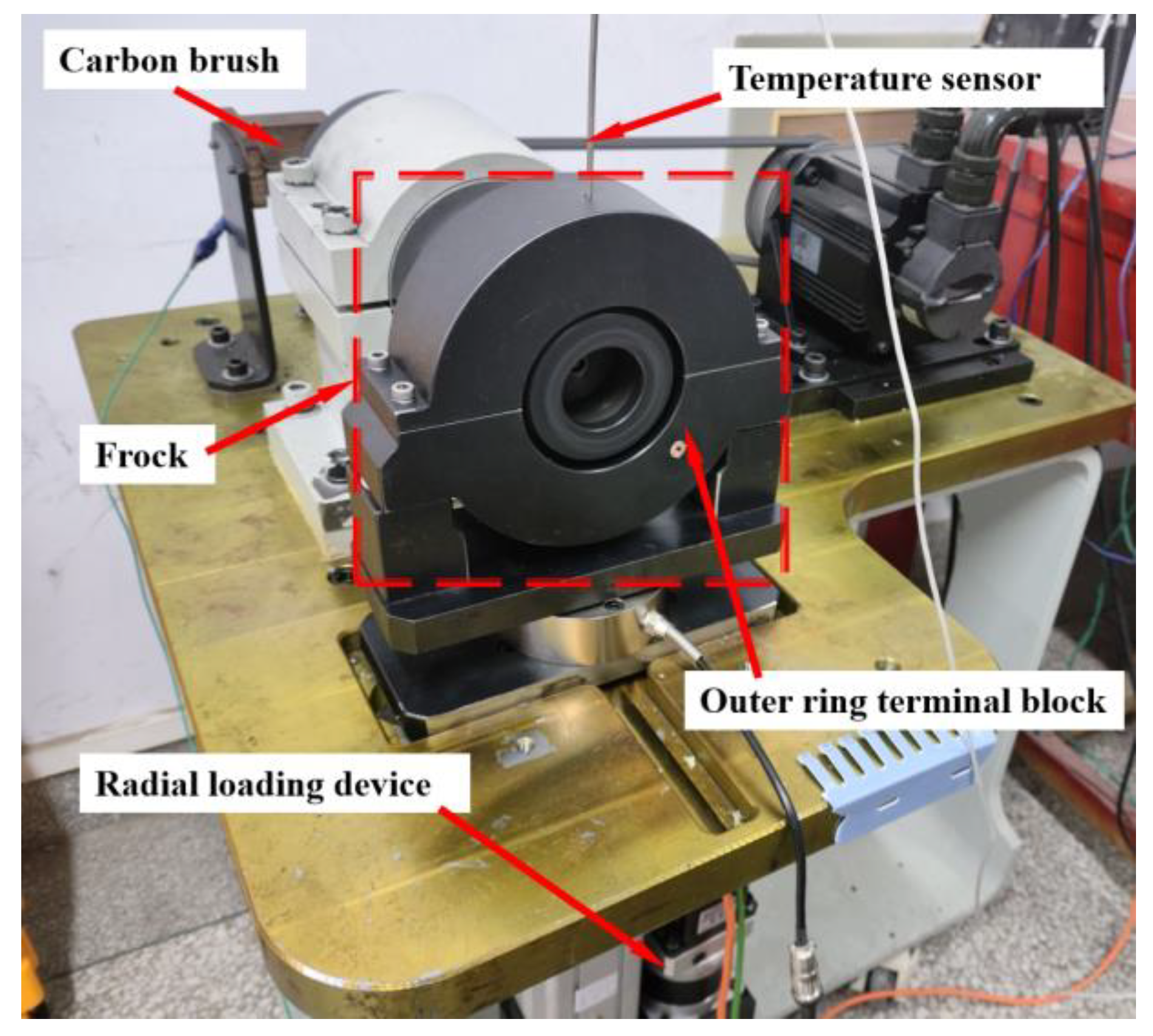


| Parameter | Meaning | Value | Parameter | Meaning | Value |
|---|---|---|---|---|---|
| Inside diameter | 75 mm | Outside diameter | 130 mm | ||
| Width | 25 mm | Bearing pitch diameter | 102.5 mm | ||
| Coefficient of curvature radius of inner raceway groove | 0.5097 | Coefficient of curvature radius of outer raceway groove | 0.5268 | ||
| Steel ball diameter | 17.462 mm | Number of steel balls | 11 | ||
| Radial clearance | 46~71 μm | The elastic modulus of steel | |||
| Basic dynamic radial load rating | 66,000 N | Basic static radial load rating | 49,500 N |
| Rings and Ball (Bearing Steel) | Cage (Brass) | Bearing Seat (Grey Cast Iron) | Grease | |
|---|---|---|---|---|
| Density (kg/m3) | 7850 | 8300 | 7200 | 880 |
| Specific heat (j/kg·k) | 475 | 385 | 447 | 1845 |
| Thermal conductivity (w/m·k) | 44.5 | 118 | 39.2 | 0.145 |
Disclaimer/Publisher’s Note: The statements, opinions and data contained in all publications are solely those of the individual author(s) and contributor(s) and not of MDPI and/or the editor(s). MDPI and/or the editor(s) disclaim responsibility for any injury to people or property resulting from any ideas, methods, instructions or products referred to in the content. |
© 2024 by the authors. Licensee MDPI, Basel, Switzerland. This article is an open access article distributed under the terms and conditions of the Creative Commons Attribution (CC BY) license (https://creativecommons.org/licenses/by/4.0/).
Share and Cite
Wang, H.; Li, H.; Jin, Z.; Lin, J.; Cui, Y.; Li, C.; Tian, H.; Wang, Z. Simulation Analysis and Experimental Study on the Fluid–Solid–Thermal Coupling of Traction Motor Bearings. Lubricants 2024, 12, 144. https://doi.org/10.3390/lubricants12050144
Wang H, Li H, Jin Z, Lin J, Cui Y, Li C, Tian H, Wang Z. Simulation Analysis and Experimental Study on the Fluid–Solid–Thermal Coupling of Traction Motor Bearings. Lubricants. 2024; 12(5):144. https://doi.org/10.3390/lubricants12050144
Chicago/Turabian StyleWang, Hengdi, Han Li, Zheming Jin, Jiang Lin, Yongcun Cui, Chang Li, Heng Tian, and Zhiwei Wang. 2024. "Simulation Analysis and Experimental Study on the Fluid–Solid–Thermal Coupling of Traction Motor Bearings" Lubricants 12, no. 5: 144. https://doi.org/10.3390/lubricants12050144





